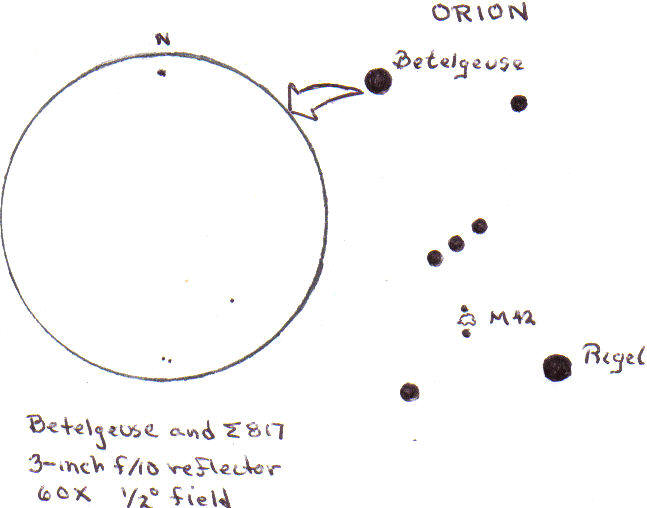Struve 817 Orionis
January 2009 :
I’m a big fan of “off-the-beaten-path” sky objects. One of my favorites is the little-known double star Struve 817 - the 817th double star catalogued by the German-born Russian astronomer F. G. W. Struve during a survey conducted between 1824 and 1827. According to a measure made in 2004 and posted in the Washington Double Star Catalog, Struve 817 consists of near-twin magnitude 8.7 and 8.9 stars separated by 18.8 ascseconds in a position angle of 73o. The separation and P.A. differ little from what Struve himself measured around the time of discovery. Double star astronomers describe stellar partnerships that show little relative motion as being “relatively fixed.” If the component stars of Struve 817 form a true binary pair, their orbital period must encompass many centuries.
What gives this relatively obscure double star a special allure is its location, less than a half degree south of the red supergiant Betelgeuse. To find Struve 817, simply aim your telescope at Betelgeuse. A medium power eyepiece (75 to 100X works well) should capture this delicate pair shining bravely beside the dazzling ruddy Betelgeuse. It’s a startling contrast. Speaking of contrast, the Washington Catalog lists the spectra of Struve 817’s components as A5 and K. Can you make out a color contrast between the two?
Some years ago, I wrote a four-part series for Deep Sky Magazine in which I introduced my favorite 100 double stars. Included with such celebrated pairs as Mizar, Albireo, and the “Double-double” epsilon Lyrae was Struve 817. On the next crisp winter night when Orion beckons you to visit his magnificent Nebula, take a minute to travel a road less taken and try for this delightful double star.
Your comments on this column are welcome. E-mail me at gchaple@hotmail.com. 



